Power electronic handbook
Подождите немного. Документ загружается.

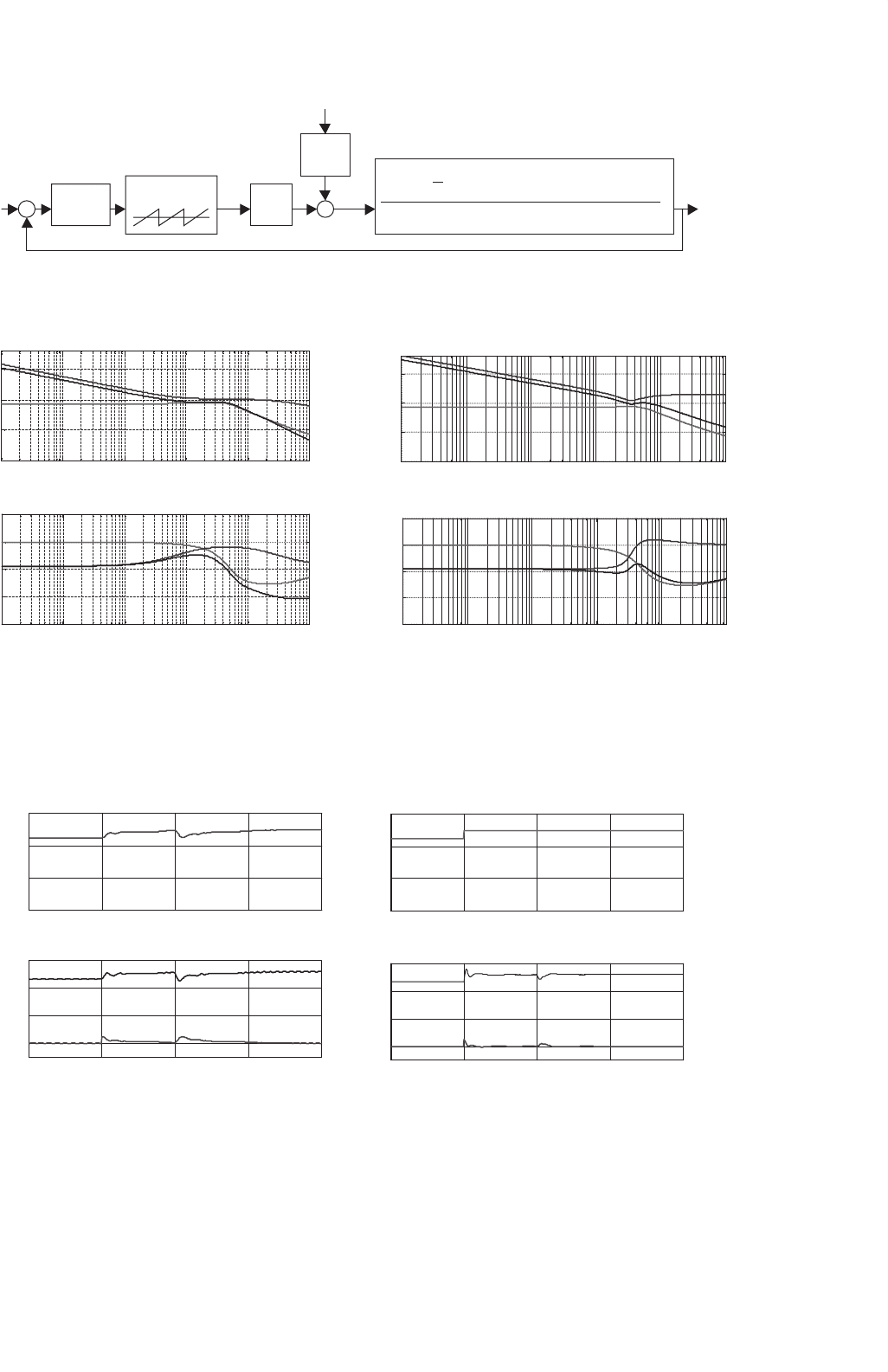
34 Control Methods for Switching Power Converters 947
v
oref
v
o
C
P(S)
u
c
Modulator
V
DC
V
DC
∆
1
δ
+
+
+
+
+
−
s
2
L
i
C
o
R
oc
+
s (L
i
+ C
o
R
oc
r
p
) + k
oc
R
oc
+r
p
2
1
n
(k
oc
R
oc
+ r
cm
+ sC
o
R
oc
r
cm
)
2
FIGURE 34.10 Block diagram of the linearized model of the closed-loop controlled forward converter.
Forward converter, Pl plus high frequency pole Forward converter, PID notch filter
Frequency (rad/s)
10
0
−100
−300
−200
−100
0
100
−50
0
50
Magnitude (dB)Phase (degrees)
−300
−200
−100
0
100
Phase (degrees)
10
1
10
2
10
3
10
4
10
5
Frequency (rad/s)
10
0
−100
−50
0
50
Magnitude (dB)
10
1
10
2
10
3
10
4
10
5
Frequency (rad/s)
(a) (b)
10
0
10
1
10
2
10
3
10
4
10
5
Frequency (rad/s)
3
3
2
2
3
3
1
1
1
2
2
1
10
0
10
1
10
2
10
3
10
4
10
5
FIGURE 34.11 Bode plots for the forward converter. Trace 1 – switching converter magnitude and phase; trace 2 – compensator magnitude and
phase; trace 3 – resulting magnitude and phase of the compensated converter: (a) PI plus high-frequency pole compensation with 115
◦
phase margin,
ω
0dB
= 500 rad/s and (b) PID notch filter compensation with 85
◦
phase margin, ω
0dB
= 6000 rad/s.
1}voref, 2}vo [V]2}10*(voref-vo) [V], 1}iL[A]
0 0.005 0.01 0.015 0.02
0
2
4
6
0
2
4
6
60
40
20
0
60
40
20
0
1}voref, 2}vo [V]
t [s]
0 0.005 0.01 0.015 0.02
0 0.005 0.01 0.015 0.02
t [s]
t [s]
(a) (b)
0 0.005 0.01 0.015 0.02
t [s]
2}10*(voref-vo) [V], 1}iL[A]
FIGURE 34.12 Transient responses of the compensated forward converter. At t = 0.005 s, v
oref
step from 4.5 to 5 V. At t = 0.01 s, V
DC
step from
300 to 260 V. Top graphs: step reference v
oref
and output voltage v
o
. Bottom graphs: top traces i
L
current; bottom traces 10× (v
oref
−v
o
); (a) PI plus
high-frequency pole compensation with 115
◦
phase margin and ω
0dB
= 500 rad/s and (b) PID notch filter compensation with 85
◦
phase margin and
ω
0dB
= 6000 rad/s.
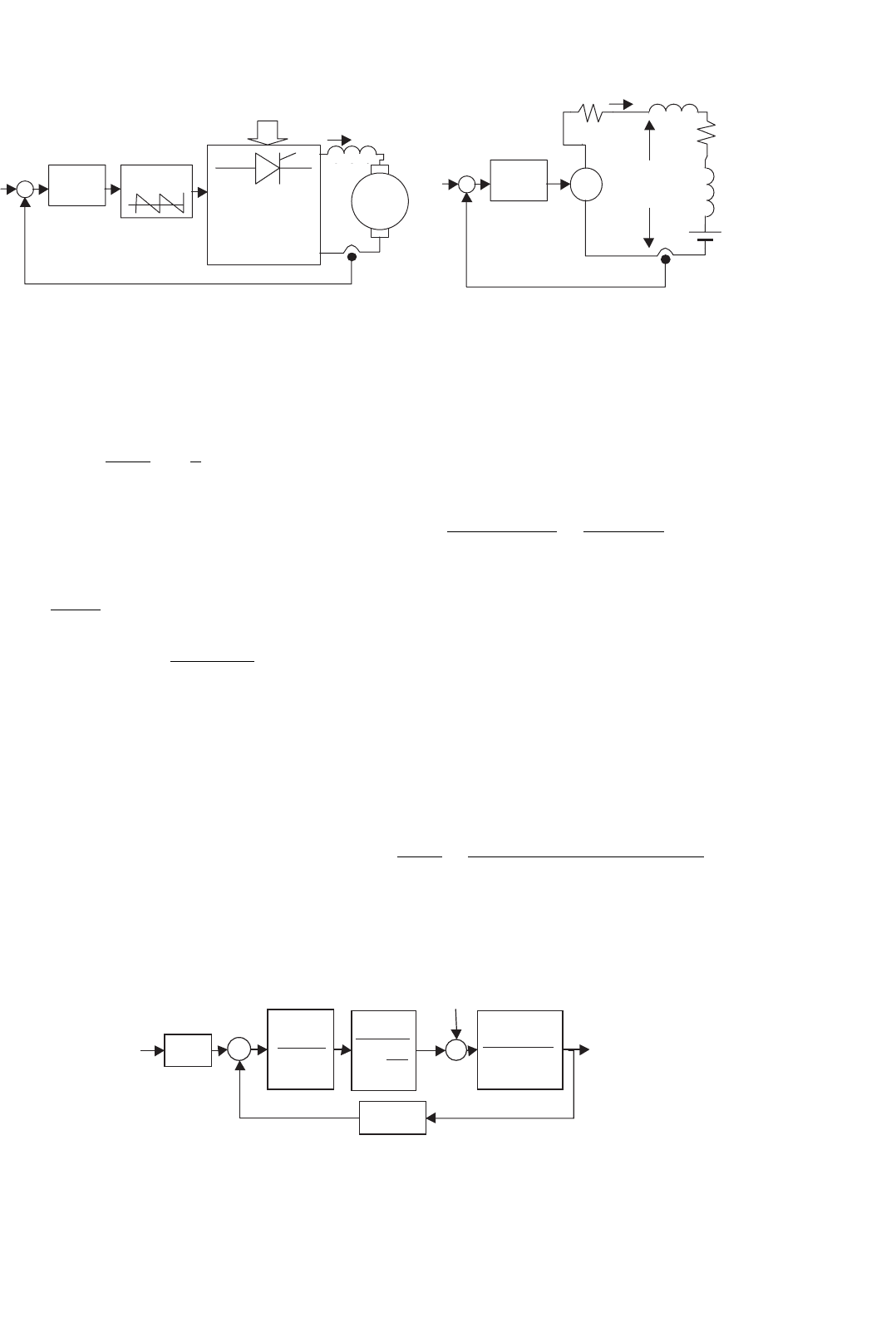
948 J. F. Silva and S. F. Pinto
dc
motor
i
oref
i
oref
i
o
L
o
k
I
i
o
k
I
i
o
C
p(s)
C
p(s)
K
R
u
c
u
o
u
c
u
c
R
i
i
o
R
m
L
m
E
o
L
o
u
o
++
−
+
−
+
+
+
−
−
+
+
−
−
Modulator
(a) (b)
ac mains
p pulse, phase
controlled
rectifier
α
FIGURE 34.13 (a) Block diagram of a p pulse phase controlled rectifier feeding a separately excited dc motor and (b) equivalent averaged circuit.
points, the maximum value of K
R
, denoted K
RM
, can
be used:
K
RM
= U
p
p
2u
cmax
sin
π
p
(34.56)
The operation of the modulator, coupled to the recti-
fier thyristors, introduces a non-neglectable time delay,
with mean value T /2p. Therefore, from Eq. (34.48) the
modulator-rectifier transfer function G
R
(s)is
G
R
(s) =
U
DC
(s)
u
c
(s)
= K
RM
e
−s
(
T/2p
)
≈
K
RM
1 +s
T/2p
(34.57)
Considering zero U
p
perturbations, the rectifier
equivalent averaged circuit (Fig. 34.13b) includes the
loss-free rectifier output resistance R
i
, due to the overlap
in the commutation phenomenon caused by the mains
inductance. Usually, R
i
≈ pωl/π where l is the equiva-
lent inductance of the lines paralleled during the overlap,
half of the line inductance for most rectifiers, except for
single-phase bridge rectifiers where l is the line induc-
tance. Here, L
o
is the smoothing reactor and R
m
, L
m
,
and E
o
are respectively the armature internal resistance,
inductance, and back electromotive force of a separately
excited dc motor (typical load). Assuming the mean
+
++
+
−
−
i
oref
sT
p
R
t
(1 + sT
t
)
u
c
i
o
E
o
U
DC
K
RM
T
2p
1 + sT
z
1
k
I
1 + s
k
I
i
o
k
I
FIGURE 34.14 Block diagram of a PI controlled p pulse rectifier.
value of the output current as the controlled output,
making L
t
= L
o
+ L
m
, R
t
= R
i
+ R
m
, T
t
= L
t
/R
t
and applying Laplace transforms to the differential equa-
tion obtained from the circuit of Fig. 34.13b, the output
current transfer function is
i
o
(
s
)
U
DC
(
s
)
−E
o
(
s
)
=
1
R
t
(
1 +sT
t
)
(34.58)
The rectifier and load are now represented by a per-
turbed (E
o
) second-order system (Fig. 34.14). To achieve
zero steady-state error, which ensures steady-state insen-
sitivity to the perturbations, and to obtain closed-loop
second-order dynamics, a PI controller (34.50) was
selected for C
p
(s) (Fig. 34.14). Canceling the load pole
(−1/T
t
) with the PI zero (−1/T
z
) yields:
T
z
= L
t
/R
t
(34.59)
The rectifier closed-loop transfer function i
o
(s)/i
oref
(s),
with zero E
o
perturbations, is
i
o
(s)
i
oref
(s)
=
2pK
RM
k
I
/
R
t
T
p
T
s
2
+
2p/T
s +2pK
RM
k
I
/
R
t
T
p
T
(34.60)
The final value theorem enables the verification of the
zero steady-state error. Comparing the denominator of
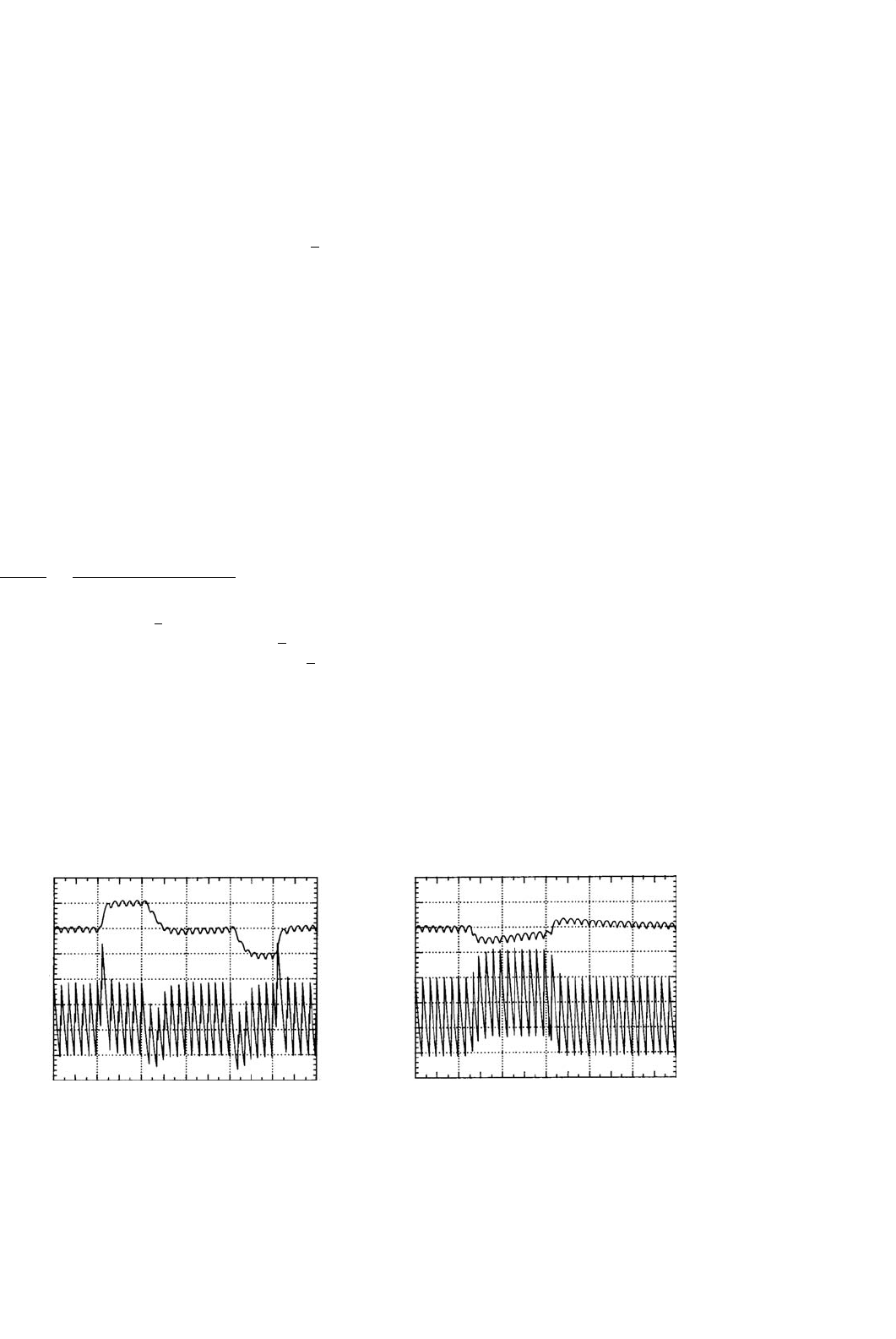
34 Control Methods for Switching Power Converters 949
Eq. (34.60) to the second-order polynomial s
2
+2ζω
n
s +
ω
2
n
yields:
ω
2
n
= 2pK
RM
k
I
/
R
t
T
p
T
4ζ
2
ω
2
n
=
2p/T
2
(34.61)
Since only one degree of freedom is available (T
p
),
the damping factor ζ is imposed. Usually ζ =
√
2/2
is selected, since it often gives the best compromise
between response speed and overshoot. Therefore, from
Eq. (34.61), Eq. (34.62) arises:
Tp = 4ζ
2
K
RM
k
I
T/
2pR
t
= K
RM
k
I
T/
pR
t
(34.62)
Note that both T
z
(34.59) and T
p
(34.62) are depen-
dent upon circuit parameters. They will have the correct
values only for dc motors with parameters closed to the
nominal load value. Using Eq. (34.62) in Eq. (34.60)
yields Eq. (34.63), the second-order closed-loop transfer
function of the rectifier, showing that, with loads close
to the nominal value, the rectifier dynamics depend only
on the mean delay time T/2p.
i
o
(s)
i
oref
(s)
=
1
2
T/2p
2
s
2
+sT/p +1
(34.63)
From Eq. (34.63) ω
n
=
√
2p/T results, which is the
maximum frequency allowed by ωT/2p <
√
2/2, the
validity limit of Eq. (34.48). This implies that ζ ≥
√
2/2,
which confirms the preceding choice. For U
p
= 300 V,
p = 6, T = 20 ms, l = 0.8 mH, R
m
= 0.5 ,
L
t
= 50 mH, E
o
=−150 V, u
cmax
= 10 V, k
I
= 0.1,
Fig. 34.15a shows the rectifier output voltage u
oN
(u
oN
=
u
o
/U
p
) and the step response of the output current
i
oN
(i
oN
= i
o
/40) in accordance with Eq. (34.63). Notice
1
u
oN
i
oN
u
oN
i
oN
1.4
1.2
1
.8
.6
.4
.2
0
−.2
.75
.5
.25
−.25
−.5
−.75
−1
0
01 2 3 4
t × 20ms
(a) (b)
56
1
u
oN
i
oN
u
oN
i
oN
1.4
1.2
1
.8
.6
.4
.2
0
−.2
.75
.5
.25
−.25
−.5
−.75
−1
0
01 2 3 4
t × 20ms
56
FIGURE 34.15 Transient response of the compensated rectifier: (a) step response of the controlled current i
o
and (b) the current i
o
response to a
step chance to 50% of the E
o
nominal value during 1.5 T.
that the rectifier is operating in the inverter mode.
Fig. 34.15b shows the effect, in the i
o
current, of a 50%
reduction in the E
o
value. The output current is initially
disturbed but the error vanishes rapidly with time.
This modeling and compensator design are valid for
small perturbations. For large perturbations either the
rectifier will saturate or the firing angles will originate
large current overshoots. For large signals, antiwindup
schemes (Fig. 34.16a) or error ramp limiters (or soft
starters) and limiters of the PI integral component
(Fig. 34.16b) must be used. These solutions will also
work with other switching converters.
To use this rectifier current controller as the inner
control loop of a cascaded controller for the dc motor
speed regulation, a useful first-order approximation of
Eq. (34.63) is i
o
(s)/i
oref
(s) ≈ 1/(sT/p +1).
Although allowing a straightforward compensator
selection and precise calculation of its parameters,
the rectifier modeling presented here is not suited
for stability studies. The rectifier root locus will con-
tain two complex conjugate poles in branches par-
allel to the imaginary axis. To study the current
controller stability, at least the second-order term
of Eq. (34.48) in Eq. (34.57) is needed. Alterna-
tive ways include the first-order Padé approximation
of e
−sT/2p
,e
−sT/2p
≈ (1 − sT/4p)/(1 + sT/4p), or
the second-order approximation, e
−sT/2p
≈ (1 −
sT/4p + (sT/2p)
2
/12)/(1 + sT/4p + (sT/2p)
2
/12). These
approaches introduce zeros in the right half-plane
(nonminimum-phase systems), and/or extra poles, giv-
ing more realistic results. Taking a first-order approxi-
mation and root-locus techniques, it is found that the
rectifier is stable for T
p
> K
RM
k
I
T/(4pR
t
)(ζ>0.25).
Another approach uses the conditions of magnitude
and angle of the delay function e
−sT/2p
to obtain the
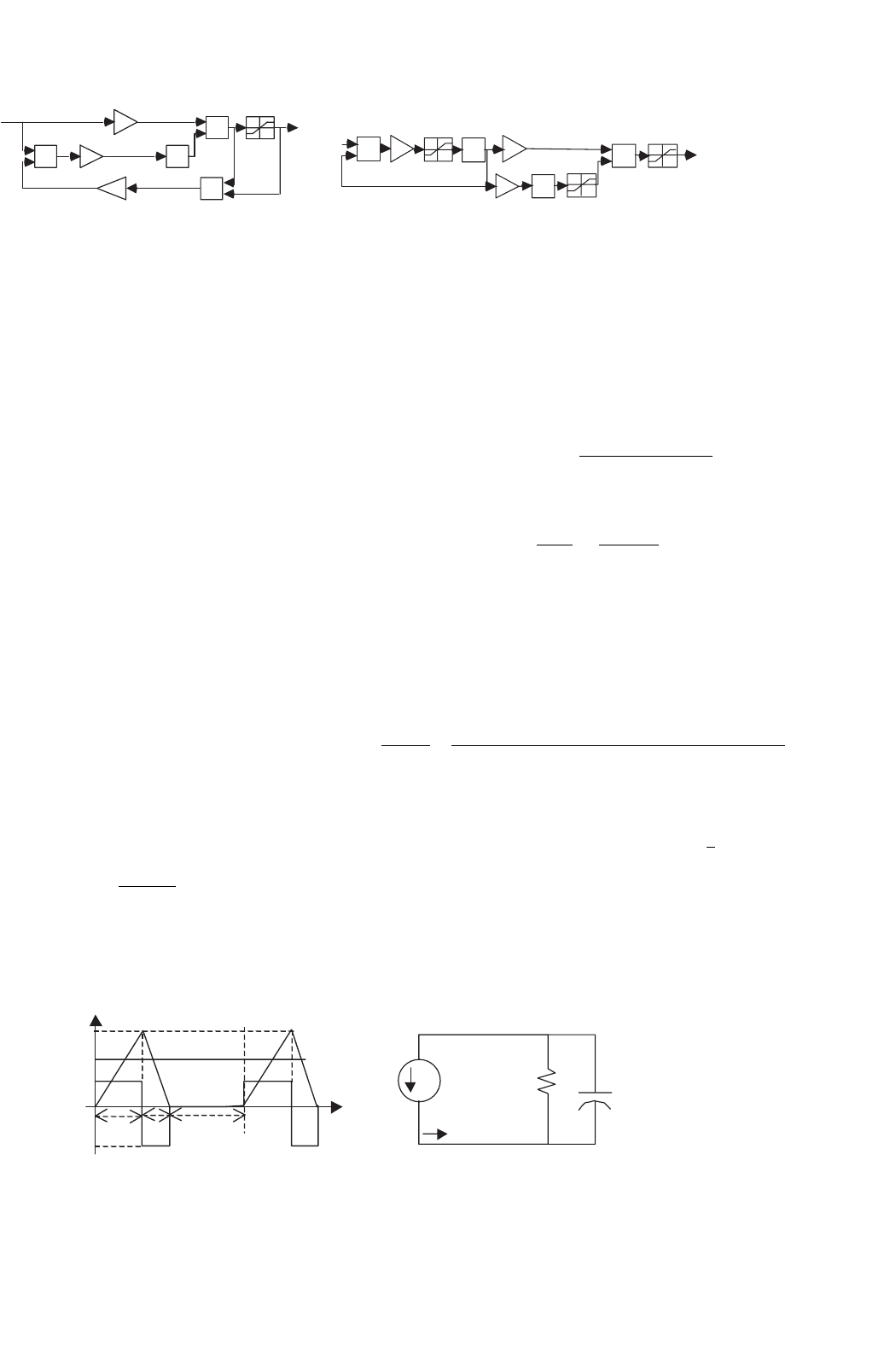
950 J. F. Silva and S. F. Pinto
limit2
(b)(a)
limit1
limit
1/s
1/s
1/s
k
r
k
w
K
p
k
i
k
i
K
p
u
e
u
e
u
c
u
c
+
+
+
+
−
−
+
−
+
−
limit3
FIGURE 34.16 (a) PI implementation with antiwindup (usually 1/K
p
≤ k
w
≤ K
i
/K
p
) to deal with rectifier saturation and (b) PI with ramp
limiter/soft starter (k
r
K
p
) and integral component limiter to deal with large perturbations.
system root locus. Also, the switching converter can be
considered as a sampled data system, at frequency p/T ,
and Z transform can be used to determine the critical
gain and first frequency of instability p/(2T), usually
half the switching frequency of the rectifier.
E
XAMPLE 34.7 Buck–Boost dc/dc converter feedback
design in the discontinuous mode
The methodologies just described do not apply to
switching converters operating in the discontinuous
mode. However, the derived equivalent averaged cir-
cuit approach can be used, calculating the mean value
of the discontinuous current supplied to the load, to
obtain the equivalent circuit. Consider the buck–boost
converter of Example 34.1 (Fig. 34.1) with the new val-
ues L
i
= 40 µH, C
o
= 1000 µF, R
o
= 15 . The mean
value of the current i
Lo
, supplied to the output capacitor
and resistor of the circuit operating in the discontinuous
mode, can be calculated noting that, if the input V
DC
and
output v
o
voltages are essentially constant (low ripple),
the inductor current rises linearly from zero, peaking at
I
P
= (V
DC
/L
i
)δ
1
T (Fig. 34.17a). As the mean value of
i
Lo
, supposed linear, is I
Lo
= (I
P
δ
2
T)/(2T), using the
steady-state input–output relation V
DC
δ
1
= V
o
δ
2
and
the above I
P
value, I
Lo
can be written:
I
Lo
=
δ
2
1
V
2
DC
T
2L
i
V
o
(34.64)
This is a nonlinear relation that could be lin-
earized around an operating point. However, switching
(a) (b)
0
I
p
−v
o
−
+
V
DC
T
δ
3
T
δ
2
Tδ
1
T
t
i
L
i
Lo
v
Li
i
L
i
Lo
i
Lo
C
o
v
o
v
o
u
c
PI
K
CV
R
o
FIGURE 34.17 (a) Waveforms of the buck–boost converter in the discontinuous mode and (b) equivalent averaged circuit.
converters in the discontinuous mode seldom oper-
ate just around an operating point. Therefore, using a
quadratic modulator (Fig. 34.18), obtained integrating
the ramp r(t) (Fig. 34.6a) and comparing the quadratic
curve to the term u
cPI
v
o
/V
2
DC
(which is easily imple-
mented using the Unitrode UC3854 integrated circuit),
the duty cycle δ
1
is δ
1
=
u
cPI
V
o
/
u
cmax
V
2
DC
, and a
constant incremental factor K
CV
can be obtained:
K
CV
=
∂I
Lo
∂u
cPI
=
T
2u
cmax
L
i
(34.65)
Considering zero-voltage perturbations and neglect-
ing the modulator delay, the equivalent averaged circuit
(Fig. 34.17b) can be used to derive the output volt-
age to input current transfer function v
o
(s)/i
Lo
(s) =
R
o
/(sC
o
R
o
+ 1). Using a PI controller (34.50), the
closed-loop transfer function is
v
o
(s)
v
oref
(s)
=
K
CV
(
1+sT
z
)
/C
o
T
p
s
2
+s
T
p
+T
z
K
CV
k
v
R
o
C
o
R
o
T
p
+K
CV
k
v
/C
o
T
p
(34.66)
Since two degrees of freedom exist, the PI constants
are derived imposing ζ and ω
n
for the second-order
denominator of Eq. (34.66), usually ζ ≥
√
2/2 and
ω
n
≤ 2πf
s
/10. Therefore:
T
p
= K
CV
k
v
ω
2
n
C
o
T
z
= T
p
(
2ζω
n
C
o
R
o
−1
)
K
CV
k
v
R
o
(34.67)
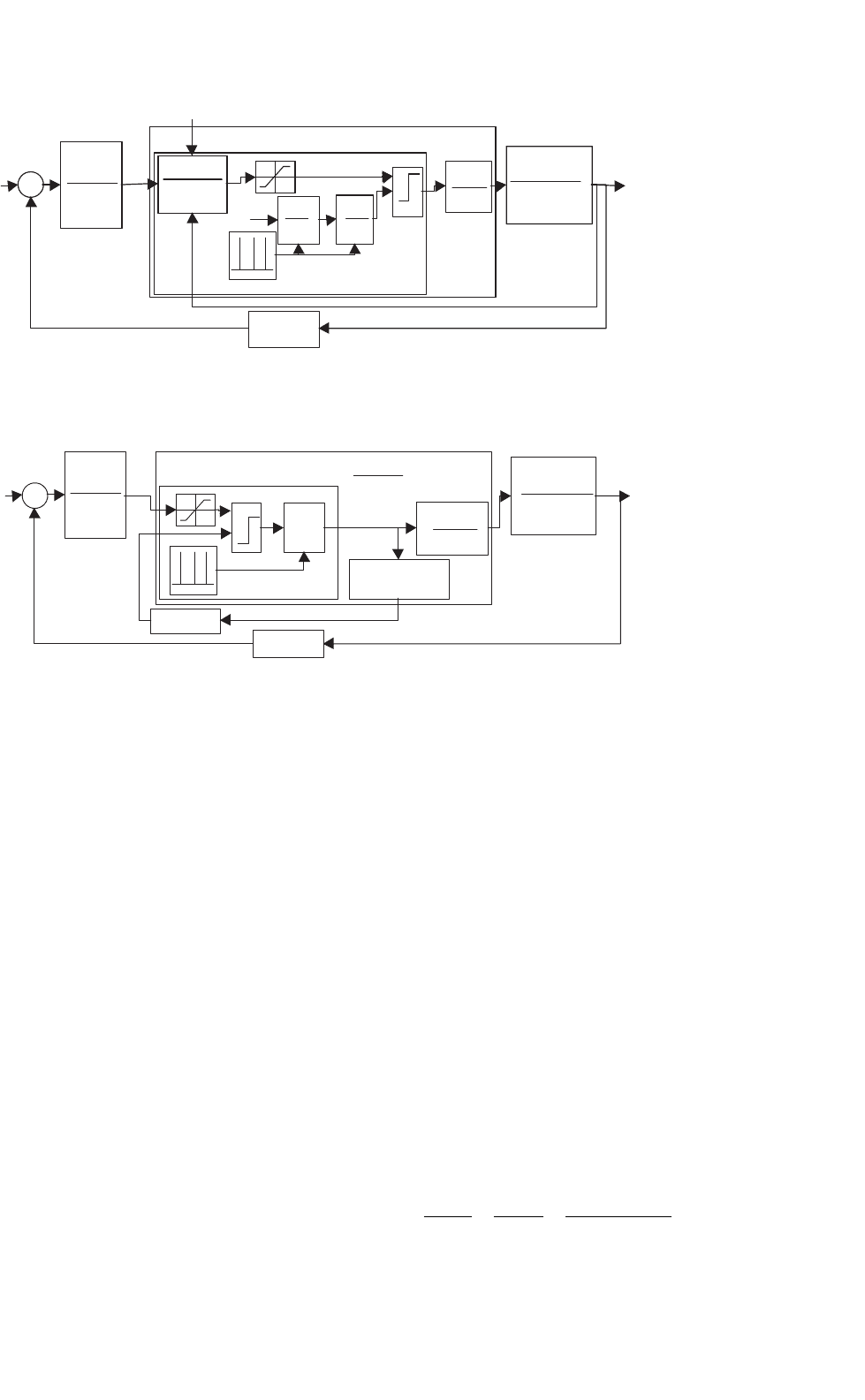
34 Control Methods for Switching Power Converters 951
v
oref
V
DC
i
Lo
δ
1
(s)
K
CV
u
c
u
cmax
T s
1
T s
k
v
q(s)
r(s)
2
u
cPI
u
cPI
V
DC
V
o
k
I
i
o
1 + sT
z
sT
p
+
+
−
+
−
2
V
DC
T
2
Reset
Quadratic
modulator
clock
2L
i
V
o
R
o
sC
o
R
o
+ 1
v
o
FIGURE 34.18 Block diagram of a PI controlled (feedforward linearized) buck–boost converter operating in the discontinuous mode.
v
oref
+
−
+
+
−
k
I
i
o
1 + sT
z
u
cPl
k
I
k
v
sT
p
Modulator
Switching cell
and L
i
i
L
i
Lo
I
Setclock
Reset
RQ
S
2V
o
IpV
DC
R
o
v
o
sC
o
R
o
+ 1
1 + sTd
K
CM
δ
1
(s)
FIGURE 34.19 Block diagram of a current-mode controlled buck–boost converter operating in the discontinuous mode.
The transient behavior of this converter, with ζ = 1
and ω
n
≈ πf
s
/10, is shown in Fig. 34.20a. Compared
to Example 34.2, the operation in the discontinuous
conduction mode reduces, by 1, the order of the state-
space averaged model and eliminates the zero in the
right-half of the complex plane. The inductor current
does not behave as a true state variable, since during
the interval δ
3
T this current is zero, and this value is
always the i
Lo
current initial condition. Given the dif-
ferences between these two examples, care should be
taken to avoid the operation in the continuous mode
of converters designed and compensated for the discon-
tinuous mode. This can happen during turn-on or step
load changes and, if not prevented, the feedback design
should guarantee stability in both modes (Example 34.8,
Fig. 34.19a).
E
XAMPLE 34.8 Feedback design for the buck–boost
dc/dc converter operating in the discontinuous mode
and using current-mode control
The performances of the buck–boost converter operat-
ing in the discontinuous mode can be greatly enhanced
if a current-mode control scheme is used, instead of
the voltage mode controller designed in Example 34.7.
Current-mode control in switching converters is the
simplest form of state feedback. Current mode needs
the measurement of the current i
L
(Fig. 34.1) but greatly
simplifies the modulator design (compare Fig. 34.18 to
Fig. 34.19), since no modulator linearization is used.
The measured value, proportional to the current i
L
,is
compared to the value u
cPI
given by the output voltage
controller (Fig. 34.19). The modulator switches off the
power semiconductor when k
I
I
P
= u
cPI
.
Expressed as a function of the peak i
L
current I
P
, I
Lo
becomes (Example 34.7) I
Lo
= I
P
δ
1
V
DC
/(2V
o
), or con-
sidering the modulator task I
Lo
= u
cPI
δ
1
V
DC
/(2k
I
V
o
).
For small perturbations, the incremental gain is K
CM
=
∂I
Lo
/∂u
cPI
= δ
1
V
DC
/(2k
I
V
o
). An I
Lo
current delay T
d
=
1/(2f
s
), related to the switching frequency f
s
can be
assumed. The current mode control transfer function
G
CM
(s)is
G
CM
(s)=
I
Lo
(s)
u
cPI
(s)
≈
K
CM
1+sT
d
≈
δ
1
V
DC
2k
I
V
o
(
1+sT
d
)
(34.68)
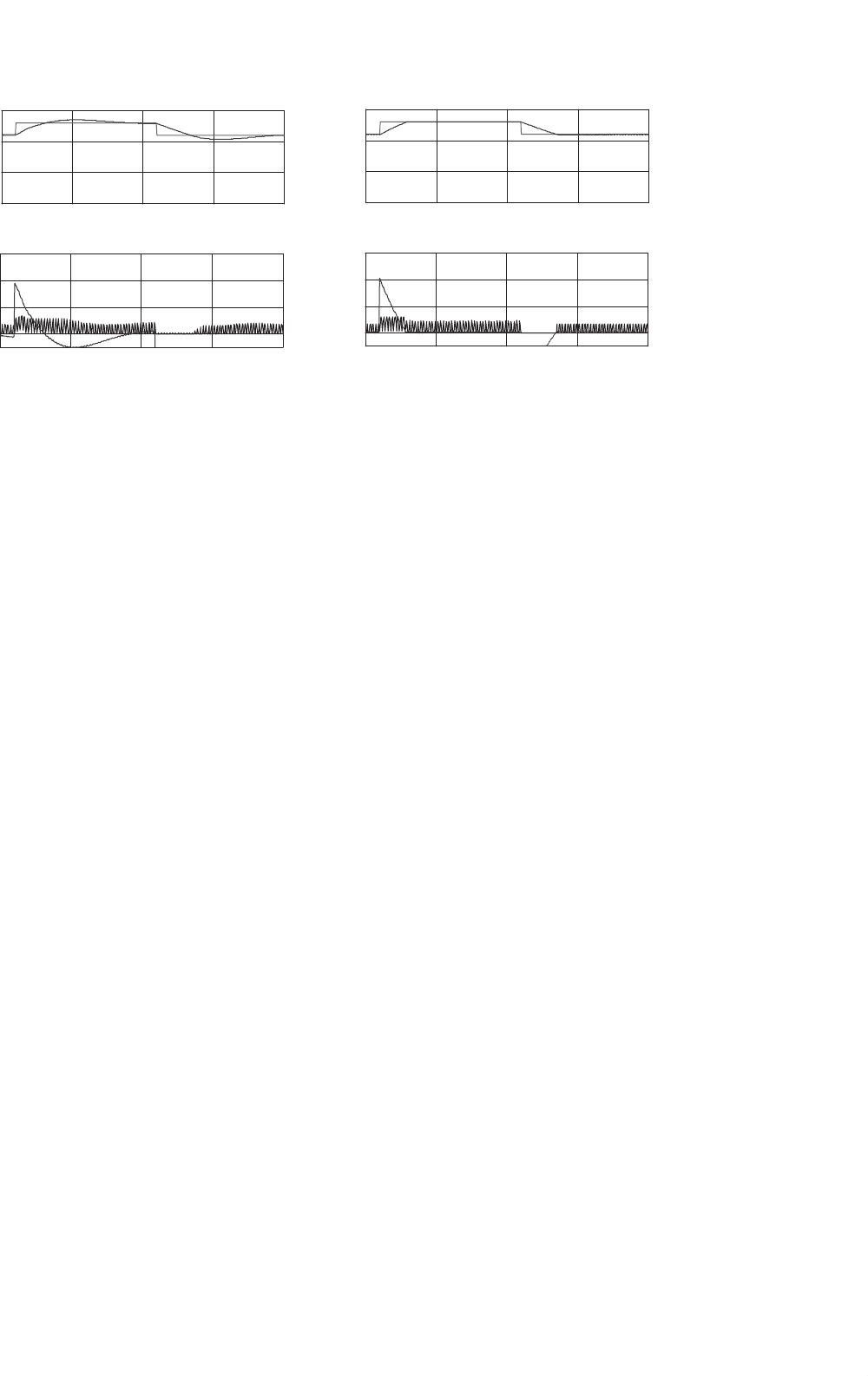
952 J. F. Silva and S. F. Pinto
0 0.005 0.01 0.015 0.02
t [s]
0 0.005 0.01 0.015 0.02
t [s]
0 0.005 0.01 0.015 0.02
t [s]
0 0.005 0.01 0.015 0.02
t [s]
(a) (b)
0
20
40
60
0
10
20
30
2}10*(voref-vo) [V], 1}iL[A]
0
20
40
60
2}10*(voref-vo) [V], 1}iL[A]
1}voref, 2}vo [V]
0
10
20
30
1}voref, 2}vo [V]
FIGURE 34.20 Transient response of the compensated buck–boost converter in the discontinuous mode. At t = 0.001 s v
oref
step from 23 to 26 V.
At t =0.011 s, v
oref
step from 26 to 23 V. Top graphs: step reference v
oref
and output voltage v
o
. Bottom graphs: pulses, i
L
current; trace peaking at 40,
10× (v
oref
− v
o
): (a) PI controlled and feedforward linearized buck–boost converter with ζ = 1 and ω
n
≈ πf
s
/10 and (b) Current-mode controlled
buck–boost with ζ = 1 and maximum value I
pmax
= 15 A.
Using the approach of Example 34.6, the values for
T
z
and T
p
are given by Eq. (34.69).
T
z
= R
o
C
o
T
p
= 4ζ
2
K
CM
k
v
R
o
T
d
(34.69)
The transient behavior of this converter, with ζ = 1
and maximum value for I
p
, I
pmax
= 15 A, is shown in
Fig. 34.19b. The output voltage step response presents
no overshoot, no steady-state error, and better dynam-
ics, compared to the response (Fig. 34.19a) obtained
using the quadratic modulator (Fig. 34.18). Notice that,
with current mode control, the converter behaves like
a reduced order system and the right half-plane zero is
not present.
The current-mode control scheme can be advanta-
geously applied to converters operating in the continu-
ous mode, guarantying short-circuit protection, system
order reduction, and better performances. However, for
converters operating in the step-up (boost) regime, a sta-
bilizing ramp with negative slope is required, to ensure
stability, the stabilizing ramp will transform the signal
u
cPI
in a new signal u
cPI
−rem(k
sr
t/T) where k
sr
is the
needed amplitude for the compensation ramp and the
function rem is the remainder of the division of k
sr
t
by T . In the next section, current control of switching
converters will be detailed.
Closed-loop control of resonant converters can be
achieved using the outlined approaches, if the resonant
phases of operation last for small intervals compared to
the fundamental period. Otherwise, the equivalent aver-
aged circuit concept can often be used and linearized,
now considering the resonant converter input–output
relations, normally functions of the driving frequency
and input or output voltages, to replace the δ
1
variable.
E
XAMPLE 34.9 Output voltage control in three-
phase voltage-source inverters using sinusoidal wave
PWM (SWPWM) and space vector modulation (SVM)
Sinusoidal wave PWM
Voltage-source three-phase inverters (Fig. 34.21) are
often used to drive squirrel cage induction motors (IM)
in variable speed applications.
Considering almost ideal power semiconductors, the
output voltage u
bk
(k ∈{1, 2, 3}) dynamics of the inverter
is negligible as the output voltage can hardly be con-
sidered a state variable in the time scale describing
the motor behavior. Therefore, the best known method
to create sinusoidal output voltages uses an open-loop
modulator with low-frequency sinusoidal waveforms
sin(ωt ), with the amplitude defined by the modulation
index m
i
(m
i
∈[0, 1]), modulating high-frequency tri-
angular waveforms r(t) (carriers), Fig. 34.22, a process
similar to the one described in Section 34.2.4.
This sinusoidal wave PWM (SWPWM) modulator
generates the variable γ
k
, represented in Fig. 34.22 by
the rectangular waveform, which describes the inverter
k leg state:
γ
k
=
1 → when m
i
sin(ωt) > r(t)
0 → when m
i
sin(ωt) < r(t)
(34.70)

34 Control Methods for Switching Power Converters 953
V
a
u
bk
Su1
S
u2S
u3
S11
S12
S13
i1
i2
i3
IM
+
_
FIGURE 34.21 IGBT-based voltage-sourced three-phase inverter with induction motor.
*
Product
0.8
Constant
Modulation Index
Sine Wave k
(PU)
Repeating
Sequence
r(t) PU
+
−
Sum
Relay
Hysterisis 10^-5
High outut = 1
Low output = 0
gamak
0 0.005 0.01 0.015 0.02
−1
−0.5
0
0.5
1
2 level PWM
t [s]
(a) (b)
FIGURE 34.22 (a) SWPWM modulator schematic and (b) main SWPWM signals.
The turn-on and turn-off signals for the k leg inverter
switches are related with the variable γ
k
as follows:
γ
k
=
1 → then Su
k
is on and sl
k
is off
0 → then Su
k
is off and sl
k
is on
(34.71)
This applies constant-frequency sinusoidally weighted
PWM signals to the gates of each insulated gate bipolar
transistor (IGBT). The PWM signals for all the upper
IGBTs (Su
k
, k ∈{1, 2, 3}) must be 120
◦
out of phase
and the PWM signal for the lower IGBT Sl
k
must be the
complement of the Su
k
signal. Since transistor turn-on
times are usually shorter than turn-off times, some dead
time must be included between the Su
k
and Sl
k
pulses
to prevent internal short-circuits.
Sinusoidal PWM can be easily implemented using a
microprocessor or two digital counters/timers generat-
ing the addresses for two lookup tables (one for the
triangular function, another for supplying the per unit
basis of the sine, whose frequency can vary). Tables can
be stored in read only memories, ROM, or erasable
programmable ROM, EPROM. One multiplier for the
modulation index (perhaps into the digital-to-analog
(D/A) converter for the sine ROM output) and one
hysteresis comparator must also be included.
With SWPWM, the first harmonic maximum ampli-
tude of the obtained line-to-line voltage is only about
86% of the inverter dc supply voltage V
a
. Since it is
expectable that this amplitude should be closer to V
a
,
different modulating voltages (for example, adding a
third-order harmonic with one-fourth of the funda-
mental sine amplitude) can be used as long as the
fundamental harmonic of the line-to-line voltage is kept
sinusoidal. Another way is to leave SWPWM and con-
sider the eight possible inverter output voltages trying
to directly use then. This will lead to space vector
modulation.
Space vector modulation
Space vector modulation (SVM) is based on the polar
representation (Fig. 34.23) of the eight possible base
output voltages of the three-phase inverter (Table 34.1,
where v
α
, v
β
are the vector components of vector
V
g
, g ∈
{0, 1, 2, 3, 4, 5, 6, 7}, obtained with Eq. (34.72). There-
fore, as all the available voltages can be used, SVM
does not present the voltage limitation of SWPWM.
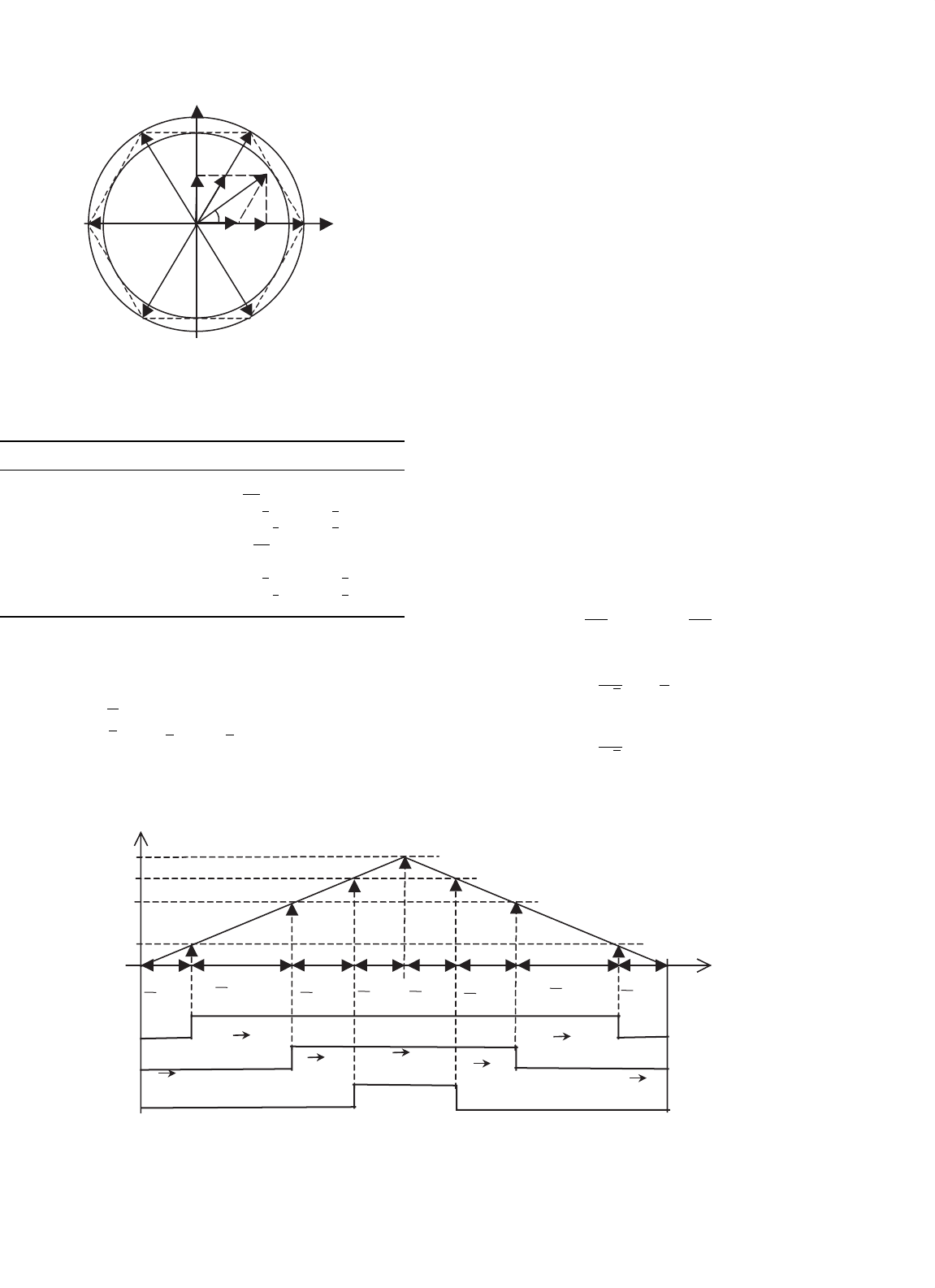
954 J. F. Silva and S. F. Pinto
V
3
V
4
V
5
V
6
V
2
V
1
V
0
,V
7
B
A
0
sector 1
sector 4
sector 3
sector 5
sector 2
sector 0
V
s
v
β
v
α
α
β
Φ
FIGURE 34.23 α, β space vector representation of the three-phase
bridge inverter leg base vectors.
TABLE 34.1 The three-phase inverter with eight possible γ
k
combina-
tions, vector numbers, and respective α, β components
γ
1
γ
2
γ
3
u
bk
u
bk
−u
bk+1
v
α
v
β
Vector
0000 0 0 0
V
0
100γ
k
V
a
(γ
k
−γ
k+1
)V
a
√
2/3V
a
0
V
1
110γ
k
V
a
(γ
k
−γ
k+1
)V
a
V
a
/
√
6 V
a
/
√
2
V
2
010γ
k
V
a
(γ
k
−γ
k+1
)V
a
−V
a
/
√
6 V
a
/
√
2
V
3
011γ
k
V
a
(γ
k
−γ
k+1
)V
a
−
√
2/3V
a
0
V
4
111V
a
000
V
7
101γ
k
V
a
(γ
k
−γ
k+1
)V
a
V
a
/
√
6 −V
a
/
√
2
V
6
001γ
k
V
a
(γ
k
−γ
k+1
)V
a
−V
a
/
√
6 −V
a
/
√
2
V
5
Furthermore, being a vector technique, SVM fits nicely
with the vector control methods often used in IM drives.
v
α
v
β
=
2
3
1 −1/2 −1/2
0
√
3/2 −
√
3/2
γ
1
γ
2
γ
3
V
a
(34.72)
u
cmax
r(t)
C
B
C
A
C
0
V
0
V
1
V
2
V
7
V
2
V
0
V
1
T
s
t
4
1
2
1
γ
1
δ
0
T
s
δ
A
T
s
2
1
δ
B
T
s
4
1
δ
0
T
s
4
1
δ
0
T
s
4
1
δ
B
T
s
2
1
δ
A
T
s
4
1
δ
0
T
s
γ
2
γ
3
0
FIGURE 34.24 Symmetrical SVM.
Consider that the vector
V
s
(magnitude V
s
, angle )
must be applied to the IM. Since there is no such vector
available directly, SVM uses an averaging technique to
apply the two vectors,
V
1
and
V
2
, closest to
V
s
. The vec-
tor
V
1
will be applied during δ
A
T
s
while vector
V
2
will
last δ
B
T
s
(where 1/T
s
is the inverter switching frequency,
δ
A
and δ
B
are duty cycles, δ
A
, δ
B
∈[0, 1]). If there is any
leftover time in the PWM period T
s
, then the zero vec-
tor is applied during time δ
0
T
s
= T
s
− δ
A
T
s
− δ
B
T
s
.
Since there are two zero vectors (
V
0
and
V
7
) a symmet-
ric PWM can be devised, which uses both
V
0
and
V
7
,
as shown in Fig. 34.24. Such a PWM arrangement mini-
mizes the power semiconductor switching frequency and
IM torque ripples.
The input to the SVM algorithm is the space vector
V
s
, into the sector s
n
, with magnitude V
s
and angle
s
.
This vector can be rotated to fit into sector 0 (Fig. 34.23)
reducing
s
to the first sector, =
s
− s
n
π/3. For
any
V
s
that is not exactly along one of the six nonnull
inverter base vectors (Fig. 34.23), SVM must generate
an approximation by applying the two adjacent vectors
during an appropriate amount of time. The algorithm
can be devised considering that the projections of
V
s
,
onto the two closest base vectors, are values proportional
to δ
A
and δ
B
duty cycles. Using simple trigonometric
relations in sector 0 (0 <<π/3) Fig. 34.23, and
considering K
T
the proportional ratio, δ
A
and δ
B
are,
respectively, δ
A
= K
T
OA and δ
B
=K
T
OA, yielding:
δ
A
= K
T
2V
s
√
3
sin
π
3
−
δ
B
= K
T
2V
s
√
3
sin
(34.73)
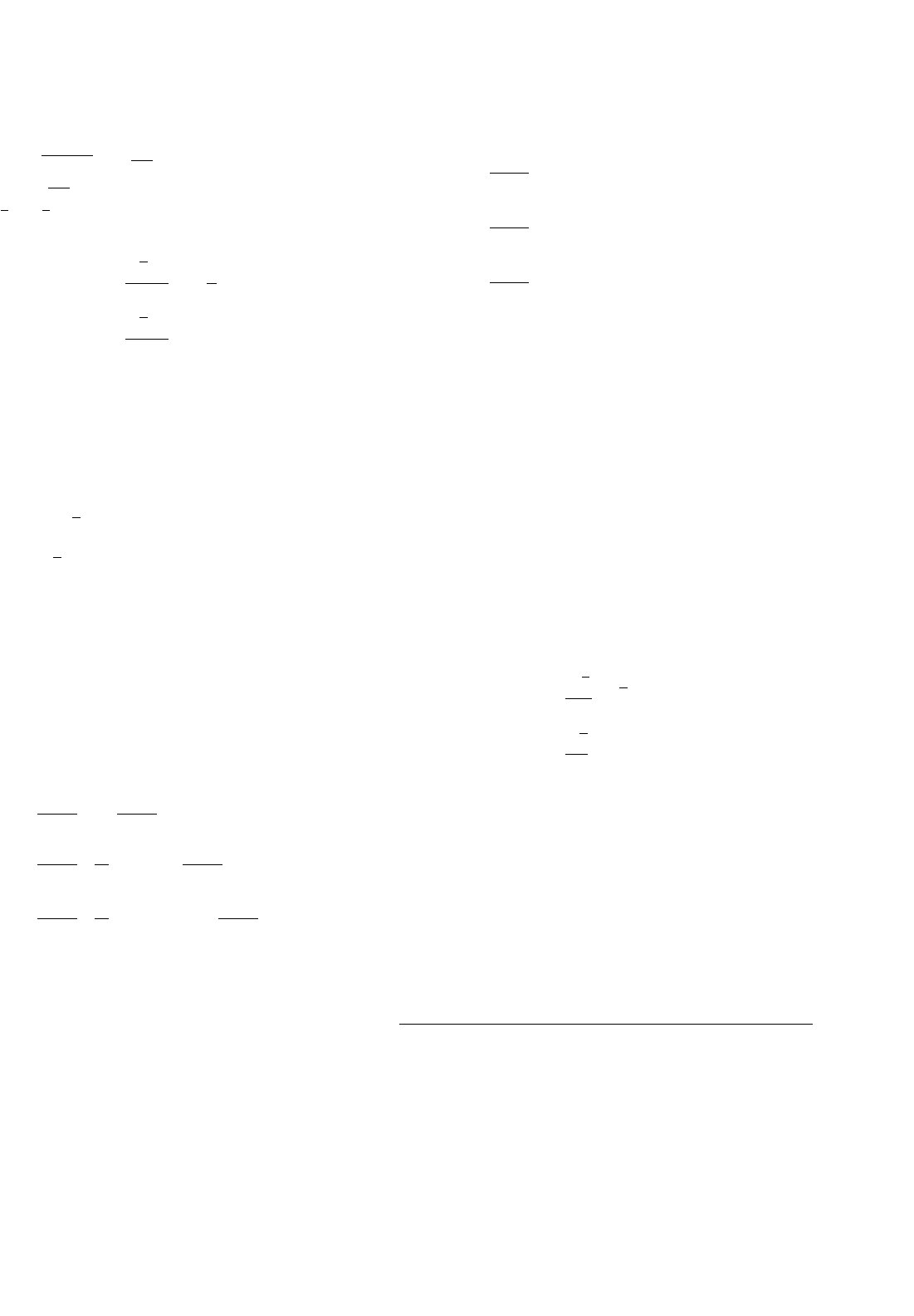
34 Control Methods for Switching Power Converters 955
The K
T
value can be found if we notice that when
V
s
=
V
1
, δ
A
= 1, and δ
B
= 0 (or when
V
s
=
V
2
,
δ
A
= 0, and δ
B
= 1). Therefore, since when
V
s
=
V
1
,
V
s
=
v
2
α
+v
2
β
=
√
2/3V
a
, = 0, or when
V
s
=
V
2
,
V
s
=
√
2/3V
a
, = π/3, the K
T
constant is K
T
=
√
3
√
2V
a
. Hence:
δ
A
=
√
2 V
s
V
a
sin
π
3
−
δ
B
=
√
2 V
s
V
a
sin
δ
0
= 1 −δ
A
−δ
B
(34.74)
The obtained resulting vector
V
s
cannot extend
beyond the hexagon of Fig. 34.23. This can be under-
stood if the maximum magnitude V
sm
of a vector with
= π/6 is calculated. Since, for = π/6, δ
A
= 1/2, and
δ
B
= 1/2 are the maximum duty cycles, from Eq. (34.74)
V
sm
= V
a
/
√
2 is obtained. This magnitude is lower than
that of the vector
V
1
since the ratio between these magni-
tudes is
√
3/2. To generate sinusoidal voltages, the vector
V
s
must be inside the inner circle of Fig. 34.23, so that it
can be rotated without crossing the hexagon boundary.
Vectors with tips between this circle and the hexagon
are reachable, but produce nonsinusoidal line-to-line
voltages.
For sector 0, (Fig. 34.23) SVM symmetric PWM
switching variables (γ
1
, γ
2
, γ
3
) and intervals (Fig. 34.24)
can be obtained by comparing a triangular wave
with amplitude u
cmax
, (Fig. 34.24, where r(t ) =
2u
cmax
t/T
s
, t ∈[0, T
s
/2]) with the following values:
C
0
=
u
c max
2
δ
0
=
u
c max
2
(1 −δ
A
−δ
B
)
C
A
=
u
c max
2
δ
0
2
+δ
A
=
u
c max
2
(1 +δ
A
−δ
B
)
C
B
=
u
c max
2
δ
0
2
+δ
A
+δ
B
=
u
c max
2
(1 +δ
A
+δ
B
)
(34.75)
Extension of Eq. (34.75) to all six sectors can be done
if the sector number s
n
is considered, together with the
auxiliary matrix :
T
=
−1 −111 1 −1
−1111−1 −1
(34.76)
Generalization of the values C
0
, C
A
, and C
B
, denoted
C
0sn
, C
Asn
, and C
Bsn
are written in Eq. (34.77), knowing
that, for example,
((sn+4)
mod 6
+1)
is the matrix row
with number (s
n
+4)
mod 6
+1.
C
0sn
=
u
c max
2
1 +
((
Sn
)
mod 6
+1
)
δ
A
δ
B
C
Asn
=
u
c max
2
1 +
((
Sn+4
)
mod 6
+1
)
δ
A
δ
B
C
Bsn
=
u
c max
2
1 +
((
Sn+2
)
mod 6
+1
)
δ
A
δ
B
(34.77)
Therefore, γ
1
, γ
2
, γ
3
are:
γ
1
=
0 → when r(t) < C
0sn
1 → when r(t) > C
0sn
γ
2
=
0 → when r(t) < C
Asn
1 → when r(t) > C
Asn
(34.78)
γ
3
=
0 → when r(t) < C
Bsn
1 → when r(t) > C
Bsn
Supposing that the space vector
V
s
is now specified
in the orthogonal coordinates α, β(
V
α
,
V
β
), instead of
magnitude V
s
and angle
s
, the duty cycles δ
A
, δ
B
can
be easily calculated knowing that v
α
= V
s
cos , v
β
=
V
s
sin and using Eq. (34.74):
δ
A
=
√
2
2V
a
√
3v
α
−v
β
δ
B
=
√
2
V
a
v
β
(34.79)
This equation enables the use of Eqs. (34.77) and
(34.78) to obtain SVM in orthogonal coordinates.
Using SVM or SWPWM, the closed-loop control of
the inverter output currents (induction motor stator
currents) can be performed using an approach similar
to that outlined in Example 34.6 and decoupling the
currents expressed in a d, q rotating frame.
34.3 Sliding-mode Control of Switching
Converters
34.3.1 Introduction
All the designed controllers for switching power converters
are in fact variable structure controllers, in the sense that the
control action changes rapidly from one to another of, usu-
ally, two possible δ(t) values, cyclically changing the converter
topology. This is accomplished by the modulator (Fig. 34.6),
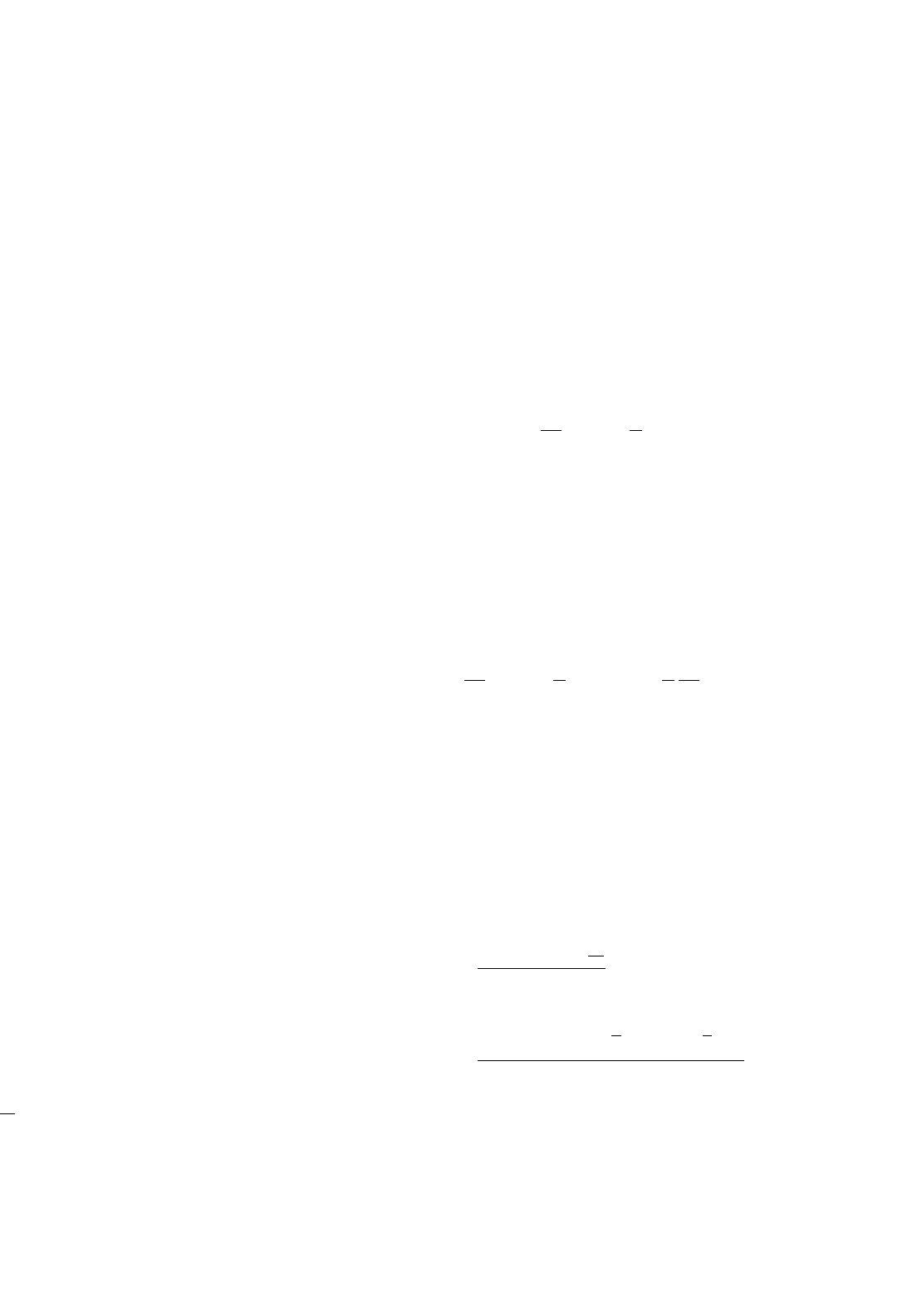
956 J. F. Silva and S. F. Pinto
which creates the switching variable δ(t) imposing δ(t) = 1
or δ(t) = 0, to turn on or off the power semiconductors.
As a consequence of this discontinuous control action, indis-
pensable for efficiency reasons, state trajectories move back
and forth around a certain average surface in the state-space,
and variables present some ripple. To avoid the effects of this
ripple in the modeling and to apply linear control methodolo-
gies to time-variant systems, average values of state variables
and state-space averaged models or circuits were presented
(Section 34.2). However, a nonlinear approach to the mod-
eling and control problem, taking advantage of the inherent
ripple and variable structure behavior of switching converters,
instead of just trying to live with them, would be desirable,
especially if enhanced performances could be attained.
In this approach switching converters topologies, as discrete
nonlinear time-variant systems, are controlled to switch from
one dynamics to another when just needed. If this switch-
ing occurs at a very high frequency (theoretically infinite), the
state dynamics, described as in Eq. (34.4), can be enforced
to slide along a certain prescribed state-space trajectory. The
converter is said to be in sliding mode, the allowed devia-
tions from the trajectory (the ripple) imposing the practical
switching frequency.
Sliding mode control of variable structure systems, such as
switching converters, is particularly interesting because of the
inherent robustness [11, 12], capability of system order reduc-
tion, and appropriateness to the on/off switching of power
semiconductors. The control action, being the control equiv-
alent of the management paradigm “Just in Time” (JIT),
provides timely and precise control actions, determined by
the control law and the allowed ripple. Therefore, the switch-
ing frequency is not constant over all operating regions of the
converter.
This section treats the derivation of the control (sliding
surface) and switching laws, robustness, stability, constant-
frequency operation, and steady-state error elimination nec-
essary for sliding-mode control of switching converters, also
giving some examples.
34.3.2 Principles of Sliding-mode Control
Consider the state-space switched model Eq. (34.4) of a switch-
ing converter subsystem, and input–output linearization or
another technique, to obtain, from state-space equations, one
Eq. (34.80), for each controllable subsystem output y =x.
In the controllability canonical form [13] (also known as
input–output decoupled or companion form), Eq. (34.80) is:
d
dt
[x
h
, ..., x
j−1
, x
j
]
T
=[x
h+1
, ..., x
j
, −f
h
(x) − p
h
(t)
+b
h
(x)u
h
(t)]
T
(34.80)
where x =[x
h
, ..., x
j−1
, x
j
]
T
is the subsystem state vector,
f
h
(x) and b
h
(x) are functions of x, p
h
(t) represents the exter-
nal disturbances, and u
h
(t) is the control input. In this special
form of state-space modeling, the state variables are chosen so
that the x
i+1
variable (i ∈{h, ..., j −1}) is the time derivative
of x
i
, that is x =
x
h
, ˙x
h
, ¨x
h
, ...,
m
x
h
T
, where m = j −h [14].
34.3.2.1 Control Law (Sliding Surface)
The required closed-loop dynamics for the subsystem output
vector y =x can be chosen to verify Eq. (34.81) with selected
k
i
values. This is a model reference adaptive control approach
to impose a state trajectory that advantageously reduces the
system order (j −h +1).
dx
j
dt
=−
j−1
i=h
k
i
k
j
x
i+1
(34.81)
Effectively, in a single-input single-output (SISO) subsys-
tem the order is reduced by unity, applying the restriction
Eq. (34.81). In a multiple-input multiple-output (MIMO) sys-
tem, in which ν independent restrictions could be imposed
(usually with ν degrees of freedom), the order could often be
reduced in ν units. Indeed, from Eq. (34.81), the dynamics of
the jth term of x is linearly dependent from the j − h first
terms:
dx
j
dt
=−
j−1
i=h
k
i
k
j
x
i+1
=−
j−1
i=h
k
i
k
j
dx
i
dt
(34.82)
The controllability canonical model allows the direct cal-
culation of the needed control input to achieve the desired
dynamics Eq. (34.81). In fact, as the control action should
enforce the state vector x, to follow the reference vec-
tor x
r
=
x
h
r
, ˙x
h
r
, ¨x
h
r
, ...,
m
x
h
r
T
, the tracking error vec-
tor will be e =[x
h
r
− x
h
, ..., x
j−1r
− x
j−1
, x
jr
− x
j
]
T
or
e =[e
x
h
, ..., e
xj−1
, e
x
j
]
T
. Thus, equating the sub-expressions
for dx
j
/dt of Eqs. (34.80) and (34.81), the necessary control
input u
h
(t)is
u
h
(t) =
p
h
(t) + f
h
(x) +
dx
j
dt
b
h
(x)
=
p
h
(t) + f
h
(x) −
j−1
i=h
k
i
k
j
x
i+1
r
+
j−1
i=h
k
i
k
j
e
x
i+1
b
h
(x)
(34.83)
This expression is the required closed-loop control law, but
unfortunately it depends on the system parameters, on external
perturbations and is difficult to compute. Moreover, for some
